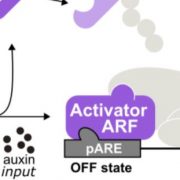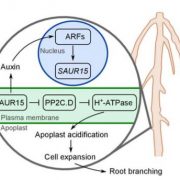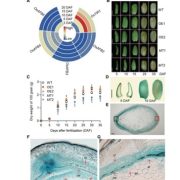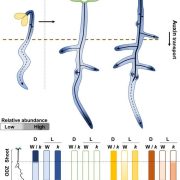Cytokinin signalling regulates auxin availability and wounding-induced adventitious rooting competency
 Adventitious roots, i.e. those derived from non-root tissues, are key elements of the plastic architecture of root systems. Auxins and cytokinins are known to induce and inhibit (respectively) adventitious root formation, though the exact mechanism remains to be fully explained. Here, Damodaran and Strader investigated the role of local conversion of indole-3-butyric acid (IBA) into indole-3-acetic acid (IAA) – both forms of auxin – in adventitious rooting competency. Following wounding of the hypocotyl, adventitious roots form mainly near the excision site, indicating that not all hypocotyl cells are competent to make roots. IAA can be obtained locally from IBA via peroxisomal beta-oxidation, and mutants unable to make this conversion produce fewer adventitious roots than the wildtype. TRANSPORTER OF IBA 1 (TOB1) can limit the supply of IBA by sequestering it into the vacuole, and tob1 plants produced more adventitious roots than wildtype, further evidencing the role of IBA-to-IAA conversion in adventitious rooting competency. Additionally, tob1 hypocotyls were insensitive to the known inhibitory effects of cytokinin on adventitious rooting, possibly due to cytokinin control of TOB1 expression. These results contribute to a more mechanistic understanding of the long-established auxin-cytokinin interplay in adventitious rooting, which will be invaluable in the development of improved protocols for clonal propagation by cuttings. (Summary by John Vilasboa @vilasjohn) Dev. Cell. 10.1016/j.devcel.2024.06.019
Adventitious roots, i.e. those derived from non-root tissues, are key elements of the plastic architecture of root systems. Auxins and cytokinins are known to induce and inhibit (respectively) adventitious root formation, though the exact mechanism remains to be fully explained. Here, Damodaran and Strader investigated the role of local conversion of indole-3-butyric acid (IBA) into indole-3-acetic acid (IAA) – both forms of auxin – in adventitious rooting competency. Following wounding of the hypocotyl, adventitious roots form mainly near the excision site, indicating that not all hypocotyl cells are competent to make roots. IAA can be obtained locally from IBA via peroxisomal beta-oxidation, and mutants unable to make this conversion produce fewer adventitious roots than the wildtype. TRANSPORTER OF IBA 1 (TOB1) can limit the supply of IBA by sequestering it into the vacuole, and tob1 plants produced more adventitious roots than wildtype, further evidencing the role of IBA-to-IAA conversion in adventitious rooting competency. Additionally, tob1 hypocotyls were insensitive to the known inhibitory effects of cytokinin on adventitious rooting, possibly due to cytokinin control of TOB1 expression. These results contribute to a more mechanistic understanding of the long-established auxin-cytokinin interplay in adventitious rooting, which will be invaluable in the development of improved protocols for clonal propagation by cuttings. (Summary by John Vilasboa @vilasjohn) Dev. Cell. 10.1016/j.devcel.2024.06.019









